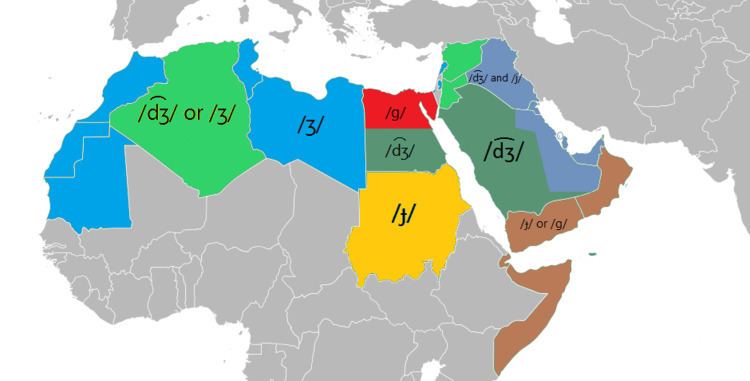Phonemic representation d͡ʒ, ʒ, ɡ, ɟ, ɣ Numerical value 3 | Position in alphabet 3 | |
 | ||
Gimel is the third letter of the Semitic abjads, including Phoenician Gīml , Hebrew ˈGimel ג, Aramaic Gāmal , Syriac Gāmal ܓ, and Arabic ǧīm ج (in alphabetical order; fifth in spelling order). Its sound value in the original Phoenician and in all derived alphabets, save Arabic, is a voiced velar plosive [ɡ]; in Modern Standard Arabic, it represents either a /d͡ʒ/ or /ʒ/ for most Arabic speakers except in Lower Egypt, the southern parts of Yemen and some parts of Oman where it is pronounced as a voiced velar plosive [ɡ], see below and also Persian Gaf گ.
Contents
In its unattested Proto-Canaanite form, the letter may have been named after a weapon that was either a staff sling or a throwing stick, ultimately deriving from a Proto-Sinaitic glyph based on the hieroglyph below:
The Phoenician letter gave rise to the Greek gamma (Γ), the Latin C and G, and the Cyrillic Г.
Arabic ǧīm
The Arabic letter ج is named جيم ǧīm. It is written is several ways depending in its position in the word:
in most Modern Standard Arabic (Literary Arabic) registers the standard pronunciation, is the affricate [d͡ʒ] (which is also, the only acceptable value when reciting Quran) or, less often, the fricative [ʒ], except in lower Egypt. Differences in pronunciation occur, because speakers of Modern Standard Arabic pronounce words in accordance to their spoken variety of Arabic. In such varieties, cognate words will have consistent differences in pronunciation of this sound:
Egyptians always use the letter to represent [ɡ], as well as in names and loanwords, such as جولف "golf". However, it isn't incorrect to use it in Egypt for transcribing /ʒ/~/d͡ʒ/ (normally pronounced [ʒ]). The opposite isn't incorrect among other Arabic language speakers.
In Perso-Arabic script, it is called jīm.
In Egypt, when there is a need to transcribe /ʒ/ or /d͡ʒ/, both are approximated into [ʒ] using چ. In Persian, Urdu, Sindhi, Ottoman Turkish and other languages using Perso-Arabic script, چ represents the affricate /t͡ʃ/.
Variations
Hebrew spelling: גִּימֵל
Bertrand Russell posits that the letter's form is a conventionalized image of a camel. The letter may be the shape of the walking animal's head, neck, and forelegs. Barry B. Powell, a specialist in the history of writing, states "It is hard to imagine how gimel = "camel" can be derived from the picture of a camel (it may show his hump, or his head and neck!)".
Gimel is one of the six letters which can receive a dagesh. The two functions of dagesh are distinguished as either qal (light) or hazaq (strong). The six letters are bet, gimel, daled, kaph, pe, and taf. Three of them (bet, kaph, and pe) have their sound value changed in modern Hebrew from the fricative to the plosive by adding a dagesh. The other three represent the same pronunciation in modern Hebrew, but have had alternate pronunciations at other times and places. They are essentially pronounced in the fricative as ג gh غ, dh ذ and th ث. In the Temani pronunciation, gimel represents /ɡ/, /ʒ/, or /d͡ʒ/ when with a dagesh, and /ɣ/ without a dagesh. In modern Hebrew, the combination ג׳ (gimel followed by a geresh) is used in loanwords and foreign names to denote [d͡ʒ].
Significance
In gematria, gimel represents the number three.
It is written like a vav with a yud as a "foot", and it resembles a person in motion; symbolically, a rich man running after a poor man to give him charity, as in the Hebrew alphabet gimel directly precedes dalet, which signifies a poor or lowly man, from the Hebrew word dal (b. Shabbat, 104a).
The word gimel is related to gemul, which means 'justified repayment', or the giving of reward and punishment.
Gimel is also one of the seven letters which receive special crowns (called tagin) when written in a Sefer Torah. See shin, ayin, teth, nun, zayin, and tsadi.
In Modern Hebrew, the frequency of usage of gimel, out of all the letters, is 1.26%.
In the Syriac alphabet, the third letter is ܓ — Gamal in eastern pronunciation, Gomal in western pronunciation (ܓܵܡܵܠ). It is one of six letters that represent two associated sounds (the others are Bet, Dalet, Kaph, Pe and Taw). When Gamal/Gomal has a hard pronunciation (qûššāyâ ) it represents [ɡ], like "goat". When Gamal/Gomal has a soft pronunciation (rûkkāḵâ ) it traditionally represents [ɣ] (ܓ݂ܵܡܵܠ), or Ghamal/Ghomal. The letter, renamed Jamal/Jomal, is written with a tilde/tie either below or within it to represent the borrowed phoneme [d͡ʒ] (ܓ̰ܡܵܠ), which is used in Garshuni and some Neo-Aramaic languages to write loan and foreign words from Arabic or Persian.
Ethiopian/Sudanese Gimel
The dialect of Eastern Africa often utilizes the gimel sofit when the gimel ends a word. The letter is a traditional gimel with an add-on curve on the bottom.
